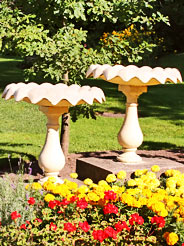 There are a number of ways to attract birds to one’s backyard. One is to provide different food sources for birds such as insects, nectars, fruits, nuts and seeds. Providing water through bird baths, ponds, streams, drippers or simply pans of water is another. Most importantly, birds should be able to feel safe in a place for them to stay. Shrubs, trees and flowers provide protection and security as birds are not out in the open.
There are a number of ways to attract birds to one’s backyard. One is to provide different food sources for birds such as insects, nectars, fruits, nuts and seeds. Providing water through bird baths, ponds, streams, drippers or simply pans of water is another. Most importantly, birds should be able to feel safe in a place for them to stay. Shrubs, trees and flowers provide protection and security as birds are not out in the open.
Feeding is probably the fastest way to a bird’s heart. Bird feeding is providing the supplemental food and water for wild birds. It is an excellent way of observing birds and their habits while being kind to the birds. It is especially beneficial to birds during winter when the natural supply of food or water is scarce or temporarily unavailable, although it may be practiced throughout the year.
A feeding station can be established where birds can be safe from attacks of predators to attract them. Birds may be attracted to a feeding station by placing food in several directions and at some distance from the station. The distance can be gradually shortened until the birds are concentrated at a desired point.
 It can be difficult to choose a specific type of feeder due to a wide range of choices. The most important factor however, is the ease of use for both the owner and the birds. A feeder that displays the seed in full view is very attractive to birds thus an open tray can be a great starter. Bird feeders should be easy to fill and be able to hold a reasonable amount of seed. The main tray feeder should be big enough for at least a dozen birds to eat at the same time.
It can be difficult to choose a specific type of feeder due to a wide range of choices. The most important factor however, is the ease of use for both the owner and the birds. A feeder that displays the seed in full view is very attractive to birds thus an open tray can be a great starter. Bird feeders should be easy to fill and be able to hold a reasonable amount of seed. The main tray feeder should be big enough for at least a dozen birds to eat at the same time.
It can be supplemented with hopper and tube-type bird feeders. Hopper-type bird feeders with plastic or glass enclosures dole out seed as they’re needed. Tube-feeders are self-contained and do not require frequent refilling so the seeds stay dry and there is less spillage when birds eat. Other types of feeders are the wire-mesh feeders, window feeders, nectar feeders and suet feeders.
There must be a source in the backyard for birds to drink and bathe. It should not be too close to the feeders as birds tend to avoid baths that have lots of other activity around them. Preening birds prefer peace and quiet when they arrange and dry their feathers.
Water is irresistible to birds in whatever form. Providing water at varying heights attract a great number of birds. Some birds would prefer ground level ponds and puddles. However, water should only be a few inches deep at the deepest place as some birds can easily drown. For bird baths that are deeper than 2”, pebbles or gravel can be placed at the bottom or simply refrain from filling the bath full. The sound of water, whether bubbling, dripping or splashing will lure birds to any backyard. Avoid bird baths with wild painted designs especially at the bottom as this may be viewed by the bird as unsafe water.
A yard can be made more inviting to birds by considering their food and shelter requirements when doing landscape plans. Remember that the reason why birds consider man-made nesting places is the lack of natural nesting places left. The closer a yard would look like their natural habitat, the easier it would for the birds to accept the alternative.